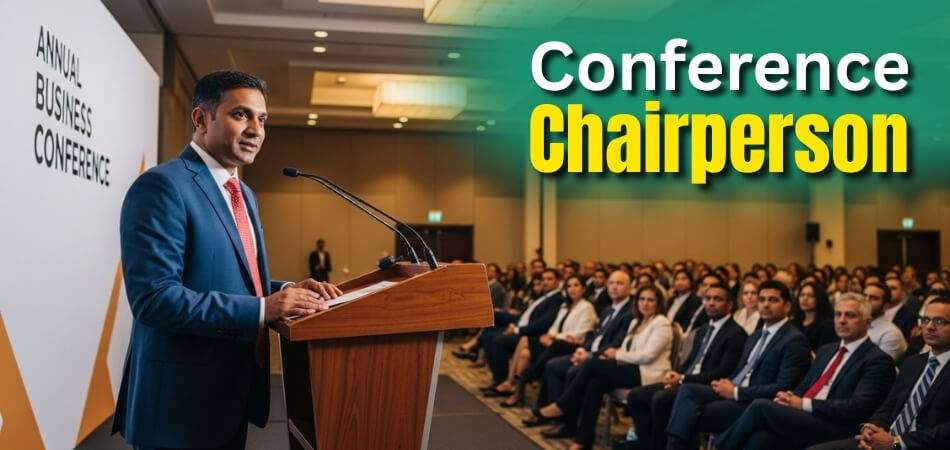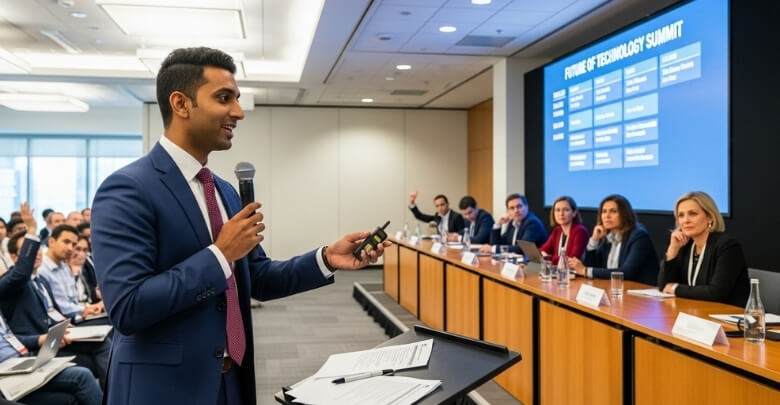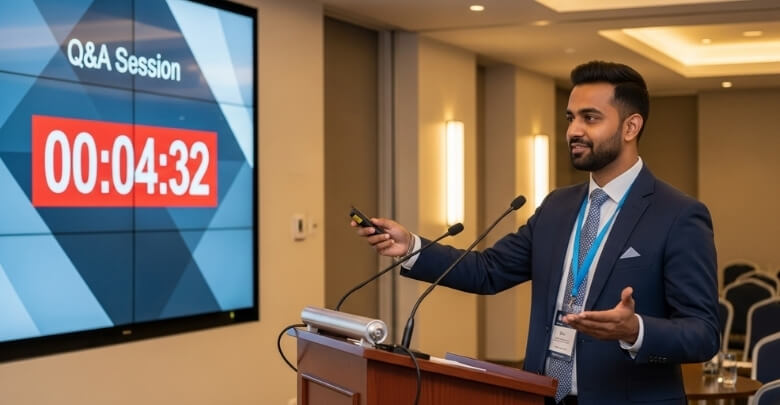There’s someone who keeps things flowing smoothly at every conference. They welcome the audience with warmth, set the stage for each speaker, and ensure that the program stays on track. When time runs short, they step in gracefully. And when questions arise, they guide the conversation with balance and fairness.
So, what is a conference chairperson?
A conference chairperson is the person who runs a session at a conference. They welcome the audience, introduce the speakers, and make sure each speaker stays on time. They also manage questions from the audience and fix any small problems to keep the session running smoothly.
Curious to learn more about this important role? Let’s dive deeper into the rest of the article.
What is a Conference Chairperson?
A conference chairperson is the person who guides and manages sessions during a conference. They welcome attendees, introduce speakers, and ensure presentations stay within time. They also moderate discussions, solve small problems, and keep everything professional. Their role creates structure, supports speakers, and ensures audiences enjoy a smooth, engaging conference experience. Here are the Key responsibilities of a conference chair during sessions:

Opening the Session
A conference chairperson starts the session by greeting attendees warmly and setting expectations clearly for the event. They outline the session agenda, highlighting housekeeping details such as time, Q&A structure, and emergency notes. This introduction sets the tone, ensuring attendees know what to expect throughout the session’s flow. A strong opening creates a welcoming atmosphere that encourages participation and attentiveness from the very beginning.
Introducing Speakers
The chairperson introduces each speaker with confidence, offering background information that highlights their expertise and achievements. These introductions provide context, preparing the audience to understand and engage with the presentation’s key points. A well-crafted introduction respects the speaker’s work while boosting audience anticipation. Smooth introductions build trust and ensure a seamless transition between different topics and presenters.
Managing Time
Timekeeping is one of the most critical responsibilities of a conference chairperson during sessions. They ensure every speaker stays within their allotted slot, preserving fairness and flow. Using signals, cards, or gentle reminders, the chairperson prevents schedule overruns without disrupting presentations. By keeping time strict yet respectful, they balance structure with flexibility, ensuring no session feels rushed or dragged.
Moderating Q&A
The chairperson leads Q&A sessions with fairness, ensuring discussions stay relevant, respectful, and engaging for everyone involved. They invite questions, encourage diverse voices, and balance audience participation while keeping the conversation focused on the presentation’s content. When questions drift off-topic or become lengthy, the chairperson redirects politely, preserving clarity and inclusivity. A well-moderated Q&A fosters dialogue, allowing presenters and audiences to connect meaningfully.
Handling Issues
Unexpected problems often arise during conferences, and the chairperson addresses them promptly and calmly. Technical glitches, logistical delays, or audience concerns are resolved with composure to maintain professionalism. Their quick action minimizes disruption, ensuring the session continues smoothly without distracting attention from presenters. Strong problem-solving skills make the chairperson an anchor, keeping everything stable regardless of challenges.
Maintaining Professionalism and Inclusivity
The chairperson fosters professionalism by encouraging respectful dialogue, diverse perspectives, and accessible communication. They may repeat audience questions to ensure clarity, making sessions inclusive for all participants. Their leadership balances authority with approachability, creating a safe and engaging environment for everyone. Professionalism and inclusivity strengthen credibility, encouraging attendees to feel valued, respected, and more willing to contribute openly.
Closing the Session
To conclude, the chairperson summarizes the main points and sincerely thanks both speakers and attendees. This recap reinforces learning and helps audiences reflect on key insights from each presentation. Expressing gratitude builds community, leaving participants with a sense of recognition and closure. Finally, they ensure a smooth transition to the next session, keeping the event flow connected and continuous.
So, the chairperson is the thread that ties sessions together at every conference. They manage time, balance voices, and solve problems calmly. Their presence ensures structure while maintaining an atmosphere of respect and inclusivity. Without them, the experience would lack rhythm, flow, and meaningful connection for both speakers and audiences.
Key Steps to Becoming a Conference Chairperson
Becoming a conference chairperson is not about luck—it is about preparation, credibility, and leadership. The path involves gaining the right experience, building skills, and earning trust within your professional or academic field. Each step strengthens your ability to guide sessions confidently and manage diverse groups effectively.
Step 1: Gain Relevant Experience
- Presenting at conferences helps you understand event structures, flow, and engagement, which later supports successful chairing. This practice also builds confidence, familiarity, and professional presence.
- Organizing smaller sessions gives real exposure to logistics, timekeeping, and speaker management, developing valuable organizational skills. Each task teaches structure, planning, and adaptability.
- Engaging actively as an attendee sharpens listening, observation, and audience awareness, vital when moderating diverse conference sessions effectively. Attention to detail becomes second nature.
Step 2: Develop Leadership and Communication Skills
- Effective leaders guide sessions with clarity, ensuring speakers, time, and discussions remain balanced while encouraging meaningful interaction. Confidence grows steadily through repetition.
- Strong communication skills allow introductions that highlight speakers’ credibility and keep participants engaged throughout the session. Clear articulation builds trust instantly.
- Practicing moderation enhances the ability to navigate challenging moments, ensuring respectful discussions and productive exchanges. This reduces tension significantly during sessions.
Step 3: Understand Meeting and Conference Rules
- Familiarity with rules ensures you can guide sessions impartially, enforcing fairness and structure without unnecessary friction. Authority feels natural, not forced.
- Learning parliamentary or organizational procedures allows smoother transitions during agenda shifts or unexpected adjustments. This knowledge creates order under stress.
- Understanding time rules strengthens your authority while helping presenters remain disciplined and professional during their allotted slots. Order replaces confusion.
Step 4: Establish Domain Expertise and Professional Credibility
- Expertise in your subject area strengthens introductions, allowing you to add meaningful context before each speaker. Audiences appreciate genuine authority.
- Building credibility with published work, research, or achievements enhances your standing with organizers, creating trust in your leadership. Respect grows naturally.
- Professional reputation makes you a likely candidate when committees seek chairs for prestigious conferences worldwide. Recognition attracts more opportunities.
Step 5: Network Within the Community
- Building relationships with colleagues and thought leaders helps you stay informed about opportunities to chair sessions. Networking creates valuable openings.
- Attending conferences in countries like the USA, Australia, or Germany exposes you to wider professional circles. Many upcoming conferences in Canada also provide spaces to connect with organizers.
- Active participation in committees and societies improves your visibility, leading to invitations to chair important sessions. Connections open new doors.
Step 6: Volunteer or Be Nominated
- Some conferences require formal nominations, making early volunteering crucial for gaining visibility and proving your dedication. Effort builds trust.
- Nominations often rely on reputation, so a consistent contribution to your field strengthens your chances of being selected. Work speaks louder.
- Offering to assist organizers shows initiative and commitment, positioning you as a responsible candidate for chairperson roles. Enthusiasm wins trust.
Step 7: Prepare Thoroughly for the Role
- Reviewing speaker presentations beforehand ensures smooth introductions and prevents unnecessary delays during live sessions. Preparation fuels session confidence.
- Checking technical needs like microphones, slides, or projectors avoids last-minute disruptions and shows professionalism. Attendees notice seamless flow.
- Meeting speakers prior to the session builds rapport, aligns expectations, and ensures everyone understands the agenda. Collaboration strengthens teamwork.
How to Build a CV to Qualify for Conference Chair Roles?
Building a CV for conference chair roles requires a clear structure, practical highlights, and thoughtful presentation of your professional journey. Organizers seek evidence of leadership, strong communication, and relevant academic or industry contributions. Showcasing your skills effectively helps you stand out from other candidates. Here’s how to structure your CV to reflect leadership and credibility.
- Highlight Presentations: Conference presentations demonstrate expertise and confidence, proving your ability to engage large audiences. Include major talks, seminars, and invited lectures.
- Show Leadership: Chairs must guide sessions with authority, so leadership roles matter. Mention positions where you led teams, committees, or professional events.
- Add Publications: Published work reinforces credibility, signaling subject mastery. Cite respected journals, books, or reports that demonstrate deep knowledge in your field.
- Mention Training: Workshops or courses improve organizational and communication skills. Including them shows ongoing growth, proving you actively prepare for leadership opportunities.
- List Committees: Participation in academic or professional committees demonstrates commitment. Highlight decision-making contributions that reveal reliability, organizational skills, and responsibility.
- Detail Networking: Strong connections often lead to nominations. Mention conferences attended, collaborations initiated, and communities where you built professional credibility.
- Include Achievements: Awards reflect excellence, enhancing trust in your abilities. Note any recognitions that highlight your impact within your professional community.
- Specify Experience: Outline roles that involved event organization or moderation. Prior work managing schedules and discussions builds confidence in your candidacy.
- State Volunteering: Volunteering reveals dedication, flexibility, and passion. Detail any roles assisting conference operations, including organizing workshops or guiding participants.
- Focus Clarity: Keep your CV concise and easy to read. Use clear formatting, bullet points, and active language to highlight strengths.
Required Skills to Become a Good Conference Chairperson
Standing in front of people can feel exciting, but also a little scary when responsibilities are big. Running a session smoothly takes more than simply talking; it means managing, listening, and guiding people in the right way. Every chairperson must handle different tasks while keeping confidence in their role. These skills together make the event better and more enjoyable for everyone.
Effective Communication
A chairperson must know how to speak clearly so everyone understands without confusion. They explain things in simple words, not long speeches. Good communication also means letting others share their ideas without interrupting. Learning and practicing these skills is very important for becoming a conference chairperson because it ensures every voice gets heard. This creates a session where everyone feels comfortable.
Active Listening
Listening is just as important as speaking when guiding a session. A chairperson pays attention to what people say carefully. They also show respect by remembering and summarizing the main points. Active listening helps connect with speakers and the audience better.
Assertiveness and Diplomacy
Sometimes tough moments come when people disagree or lose focus. A chairperson stays firm without being rude to keep things on track. They also use kind words to calm down arguments or conflicts. Balancing firmness with politeness makes people respect their leadership.
Time Management
Every speaker has only a limited minutes, so keeping track of time is crucial. A chairperson reminds presenters gently when their time is almost done. This keeps the schedule from running late or becoming messy. Managing time well makes sessions feel organized and smooth.
Leadership and Presence
People look up to a chairperson who stands confidently and leads the event properly. Presence means showing energy, calmness, and control in front of others. Leadership gives both the audience and speakers trust in the chairperson’s role. A strong presence encourages respect without needing extra effort.
Adaptability and Problem-Solving
Unexpected issues like a broken microphone or a late speaker can happen suddenly. A chairperson quickly thinks of a good solution. Staying calm during problems keeps the audience comfortable. Adaptability makes challenges seem smaller and easier to handle.
Connection with Audience
A successful chairperson doesn’t only focus on speakers but also builds a bond with the audience. They smile, make eye contact, and encourage questions. This simple connection makes everyone feel valued. It creates a friendly environment where people want to participate more.
Summarizing and Closing
The chairperson gives a short and clear summary of what was discussed at the end. They highlight the main ideas from each speaker. Saying thank you to both speakers and the audience shows respect. Closing with positivity leaves a good impression on everyone.
Differences Between a Conference Chairperson and a Session Chair
Understanding the distinction between a conference chairperson and a session chair is essential for anyone involved in academic or professional events. While both play vital roles in ensuring a conference runs smoothly, their responsibilities differ in scope and influence. Take a look at the core difference between them.
| Aspect | Conference Chairperson | Session Chair |
| Scope of Role | Oversees the entire conference or large segments of it. | Manages a specific session within the conference. |
| Main Responsibilities | Overall planning, coordination, and management of the conference, including logistics, program development, and ensuring the event runs smoothly from start to finish. | Focuses on running a single session smoothly by introducing speakers, keeping track of time, moderating Q&A, and handling issues during that session. |
| Authority | Has broader decision-making authority over the conference structure and operations. | Limited to managing the session; operates under conference guidelines. |
| Interaction with Speakers | Often involved in selecting speakers, setting the agenda, and welcoming attendees to the entire event. | Introduces individual speakers and keeps their presentations on schedule during the session. |
| Time Commitment | Involved in activities before, during, and after the entire conference. | Responsibilities are concentrated during the timeframe of a single session. |
In sum, the conference chairperson holds a broader leadership and organizational role for the full conference, while the session chair is responsible for facilitating and managing individual sessions within the conference, including timekeeping, speaker introductions, and audience interaction.
Pros and Cons of Becoming a Conference Chairperson
Taking the role of a conference chairperson can be exciting, but it also comes with challenges. The position gives you responsibilities, recognition, and chances to grow. Let’s look at the main pros and cons together.
Pros
- Gain respect from both speakers and the audience for leading the session well.
- Build stronger communication skills by regularly introducing speakers and handling questions.
- Improve leadership abilities by guiding discussions and maintaining order throughout.
- Create valuable professional connections with speakers, organizers, and participants.
- Learn time management while keeping sessions on schedule without rushing or delaying.
- Boost confidence through speaking in front of large groups regularly.
- Leave a positive impact by helping audiences enjoy meaningful and smooth sessions.
Cons
- Handling unexpected problems can feel stressful during live sessions.
- Balancing time for every speaker may sometimes upset presenters.
- Managing conflicts or disagreements in discussions requires patience and firmness.
- Carrying responsibility for smooth sessions can feel overwhelming at times.
- Limited personal focus during events because chairpersons stay busy managing details.
How to Manage Conference Sessions as a Conference Chairperson?
Standing in front of a hall filled with people can feel exciting but also slightly nerve-wracking at times. Managing a session requires more than speaking; it means balancing different responsibilities carefully. Every chairperson must keep the event running smoothly. Here are key steps to manage sessions effectively and confidently.
Starting the Session
Beginning with a warm welcome sets the right tone for the entire event. A chairperson should greet everyone confidently and share important details like the agenda. This helps the audience know what to expect during the session. A positive start makes people feel comfortable and ready to listen.
Introducing Speakers
Each speaker deserves a respectful and clear introduction. Sharing their name, background, and topic helps the audience connect easily. Introductions should be short but meaningful, giving enough context without wasting time. A smooth introduction creates respect and interest before the talk begins.
Managing Time
Keeping track of time is one of the most important duties. A chairperson should remind speakers politely when their time is almost over. Staying on schedule avoids delays and helps maintain fairness for all speakers. Good time management makes the session organized and professional.
Handling Questions
During question time, the chairperson guides the discussion so it stays respectful and on topic. They can encourage shy participants to ask questions while making sure no one dominates. Questions should be directed fairly to speakers. This creates a balanced and interactive discussion.
Solving Problems
Sometimes things go wrong, like a technical issue or a late speaker. The chairperson must stay calm and act quickly. Solving small problems without causing panic keeps everyone focused. Handling challenges smoothly shows confidence and leadership.
Engaging the Audience
Connecting with the audience makes the session lively. Smiling, making eye contact, and encouraging participation are simple but powerful steps. When the audience feels involved, they enjoy the session more. Engagement turns a regular event into an enjoyable experience.
Closing the Session
At the end, the chairperson should summarize the main points shared by speakers. Thanking both presenters and the audience leaves a good impression. A proper closing makes people feel appreciated and gives a sense of completion. Ending on a positive note keeps the energy high for the next session.
How to Prepare as a First-time Conference Chair?
Stepping into the role of a conference chair for the first time can feel exciting yet slightly overwhelming. The position brings responsibility, but also offers a chance to learn and grow. Preparation helps reduce nervousness and builds confidence quickly. With these steps, anyone can handle the role successfully.
Know the Agenda
Before the event begins, carefully read through the agenda and schedule. Knowing when each speaker presents helps you stay organized. Understanding the timing makes it easier to keep the session on track. This step is the base of smooth preparation.
Meet the Speakers
Connecting with the speakers before the session builds trust. Ask about their topics and how they want to be introduced. This helps you make the introductions smoother and more natural. Meeting them early also reduces last-minute confusion.
Check the Venue
Walking around the venue before the session is very helpful. Look at the stage, microphones, and seating arrangements. Checking everything gives you confidence on the day of the event. Familiar surroundings help reduce nervous feelings.
Practice Speaking
Practice a short welcome speech and introductions at home. This makes your words clearer and easier on the day. Speaking practice also reduces hesitation while facing a large audience. Confidence comes from repeated preparation and comfort with your words.
Plan Timekeeping
Keeping track of time is a major part of the role. Prepare signals to remind speakers politely when time is almost up. Using hand gestures, cards, or even a bell shows good preparation and reflects the qualities of an effective conference chairperson during sessions. Planning these methods in advance avoids confusion and helps everything run smoothly.
Handle Problems Calmly
Unexpected issues can happen anytime, like a technical problem or a delayed speaker. Stay calm and think of a quick solution. People notice when you manage situations without panic. Calm handling makes the session look professional and steady.
End with Gratitude
Always close the session by thanking both the speakers and the audience. A simple thank you creates a positive atmosphere. Ending with appreciation leaves a good impression on everyone. Gratitude makes people feel respected and valued.
Common Challenges a Conference Chairperson Faces
Being a conference chairperson can be exciting, but it is never without challenges. Every session comes with surprises, both big and small. Handling these challenges requires patience, confidence, and quick thinking. Let’s explore some common problems that chairpersons often deal with.
- Time Pressure: Speakers often talk longer than scheduled, forcing the chairperson to remind them politely. Keeping sessions on time requires strict discipline.
- Technical Issues: Microphones may stop working, or projectors can suddenly fail. The chairperson must act quickly and calmly to fix problems instantly.
- Audience Behavior: Sometimes people interrupt or ask irrelevant questions. Handling these situations requires patience and tact while keeping discussions respectful and focused.
- Speaker Absence: At times, a scheduled speaker might not show up. The chairperson must adjust the flow smoothly without confusing attendees.
- Conflict Moments: Disagreements may occur between audience members or speakers. Balancing fairness with firmness is necessary to keep the atmosphere respectful.
- Low Engagement: Some audiences stay quiet, making the session dull. Encouraging interaction helps create energy and keeps the event enjoyable.
- Unexpected Delays: Delays in the schedule can occur due to technical checks or speaker readiness. The chairperson must adapt quickly without losing control.
- Information Overload: When too much content is shared, audiences feel tired. A chairperson summarizes key points clearly, keeping the discussion focused.
How Can a Conference Chairperson Be Effective?
Standing in front of a full room can feel exciting but also slightly challenging. A chairperson must guide, support, and manage sessions well. The role requires confidence and patience, along with the ability to handle people. With the right approach, the session becomes smooth and enjoyable. Here are key qualities and actions that make a chairperson truly effective.
Clear Communication
An effective chairperson always communicates in simple and clear words. They keep explanations short so people easily understand them. Good communication also means listening carefully and responding kindly. Clear communication creates trust and keeps the session flowing smoothly.
Good Timekeeping
Managing time is one of the most important tasks. Every speaker deserves fair minutes to share their ideas. A chairperson reminds them politely if they go over. Timekeeping ensures the event runs smoothly without unnecessary delays.
Confidence and Presence
The way a chairperson stands and speaks shows confidence. A strong presence makes both speakers and audiences respect them. Confidence encourages people to follow their lead. Presence makes the session feel professional and well-handled.
Handling Problems
Unexpected issues may happen, like technical problems or late speakers. A good chairperson stays calm and acts quickly. Solving small problems without stress helps everyone stay focused. Calm problem-handling keeps the event moving smoothly.
Audience Engagement
An effective chairperson connects with the audience. Smiling, encouraging questions, and showing interest make people feel involved. When audiences feel engaged, they enjoy the session more. Simple gestures can create an atmosphere of energy and excitement.
Respectful Moderation
During discussions, the chairperson ensures everyone gets a chance to speak. They guide questions politely and prevent interruptions. Respectful moderation makes people feel valued and heard. This balance helps discussions remain meaningful and fair.
Strong Closing
Ending well is as important as starting well. A chairperson summarizes the main points clearly for everyone. Thanking speakers and audiences leaves a positive feeling. A strong closing creates lasting respect and appreciation.
Best Practices for Managing Q&A and Timekeeping
Running Q&A sessions and keeping track of time are two of the most important chairperson responsibilities. Both require fairness, patience, and confidence. With these practices, the session flows smoothly and everyone feels valued.
Setting Clear Rules
- At the start, explain how questions will be taken so participants know the rules clearly. This avoids unnecessary confusion later.
- Sharing limits on question length ensures discussions stay focused without one person taking over. Clear rules help keep the balance strong.
- Letting people know how much time speakers get prevents surprises. It sets expectations that are easy to follow.
Managing Q&A Smoothly
- Allow different voices to be heard by selecting questions fairly from across the audience. This creates balanced participation and interest.
- Keep the discussion respectful by politely stopping irrelevant or lengthy questions. This ensures presenters focus on sharing useful knowledge.
- Repeat or rephrase unclear questions so the whole room understands. Doing this also shows respect toward both speaker and audience.
Effective Time Signals
- Prepare signals such as cards, bells, or gestures for speakers before the session starts. This keeps the process smooth throughout.
- Remind speakers gently when their time is almost up. This avoids embarrassment and helps maintain fairness across every presentation.
- Consistently using the same method builds trust and reliability. Speakers know exactly when they need to conclude their talk.
Frequently Asked Questions About a Conference Chairperson
Many people hear about a conference chairperson but don’t fully understand what the role actually means. This position is important for keeping sessions structured, professional, and enjoyable. Here are some frequently asked questions with detailed answers.
What Is the Main Purpose of a Conference Chairperson?
The main purpose of a conference chairperson is to guide a session from beginning to end, keeping everything organized. They set the tone, maintain order, and make sure discussions remain meaningful, creating a smooth experience for both speakers and audiences.
How Is a Conference Chairperson Different From a Speaker?
A speaker presents their own research or ideas, while a chairperson manages the entire session process. The chair introduces speakers, keeps time, moderates discussions, and solves small problems, ensuring the event flows smoothly while supporting audience engagement throughout.
Who Appoints the Conference Chairperson?
In most cases, the conference program committee selects the chairperson. They choose individuals with credibility, professional experience, and leadership skills. Some conferences may also allow volunteers or nominations, but reputation and prior involvement often play a big role in the appointment.
What Qualities Make a Strong Conference Chairperson?
A strong chairperson has confidence, patience, and good communication skills. They also listen carefully, manage time, and act fairly when conflicts arise. Their leadership and calm presence encourage respect, making the event enjoyable for both the audience and the speakers.
Can a Student Serve as a Conference Chairperson?
Yes, a student can sometimes serve as a conference chairperson, especially at academic or student-focused events. They usually need prior presentation experience and involvement in organizing events. Proper preparation and guidance help them handle the responsibilities effectively during sessions.
How Does a Chairperson Handle Technical Problems?
When technical problems occur, the chairperson stays calm and seeks quick solutions with the support staff. They may adjust schedules, reassure the audience, and encourage patience. Their main goal is to minimize disruption so the session continues smoothly without panic.
Is the Role of Chairperson Paid or Voluntary?
The role of chairperson is usually voluntary and seen as a professional service. While it may not involve payment, it brings recognition, credibility, and networking opportunities. Being chosen also reflects trust in the individual’s skills and leadership abilities.
Do Chairpersons Need Training Before Leading?
Formal training is not always required, but practice and preparation help a lot. Some organizations provide workshops or short guides. Many chairpersons learn by experience, gradually improving their skills through participation in different events, conferences, or smaller sessions.
How Does a Chairperson Keep the Audience Engaged?
A chairperson engages the audience by encouraging questions, smiling, making eye contact, and ensuring discussions remain interactive. They create balance between speakers and participants, making everyone feel included. Engagement is key to keeping sessions lively and enjoyable throughout the event.
Why Is the Chairperson’s Closing Important?
The closing is important because it summarizes the key points, thanks contributors, and leaves a positive impression. It provides closure for speakers and audiences alike. A strong closing also sets the right tone for upcoming sessions or the overall conference.
Final Thoughts
Every conference needs someone to keep things running smoothly and make sure everyone feels included. A chairperson helps speakers stay on time, answers questions politely, and makes the audience feel welcome.
When we think about what is a conference chairperson, it becomes clear that their job is to keep order while making the event enjoyable. They bring balance, calmness, and structure so people can focus on the talks.
With simple skills like communication, timekeeping, and problem-solving, the chairperson makes the session smooth. Without their role, conferences could feel confusing and less meaningful for both the speakers and the audience.









